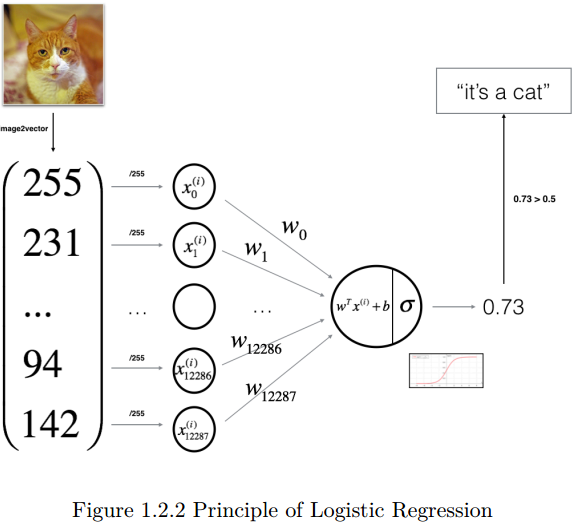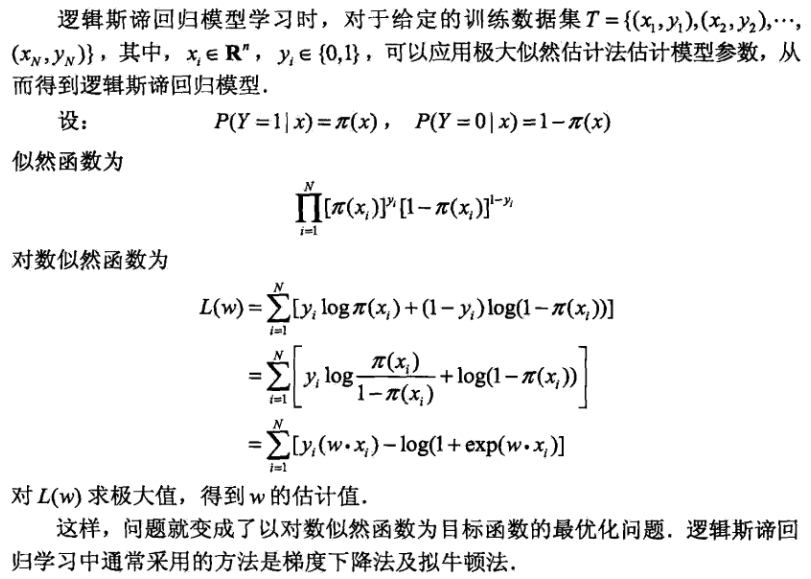1.1.2 Building basic functions with numpy
1.1.2.2 numpy.exp, sigmoid, sigmoid gradient
import numpy as np
def sigmoid(x):
s = 1/(1+np.exp(-x))
return s# 设sigmoid为s, s' = s*(1-s)
def sigmoid_derivative(x):
s = 1/(1+np.exp(-x))
ds = s*(1-s)
return ds
plt.figure(1) # 编号为1的figure
x = np.arange(-5, 5, 0.1)
y = sigmoid(x)
plt.subplot(211) # 将子图划分为2行,1列,选中2行中的第1行
plt.plot(x, y)
y = sigmoid_derivative(x)
plt.subplot(212) # 子图中2行中的第2行
plt.plot(x, y)
plt.show()
1.1.2.3 numpy.reshape(), numpy.shape
def image2vector(image):
"""
Argument:
image -- a numpy array of shape (length, height, depth)
Returns:
v -- a vector of shape (length*height*depth, 1)
"""
v = image.reshape(image.shape[0] * image.shape[1] * image.shape[2], 1)
return v
1.1.2.4 Normalizing rows
np.linalg.norm求对矩阵x按axis作向量内积
def normalizeRows(x):
"""
Implement a function that normalizes each row of the matrix x (to have
unit length).
Argument:
x -- A numpy matrix of shape (n, m)
Returns:
x -- The normalized (by row) numpy matrix. You are allowed to modify x.
"""
# Compute x_norm as the norm 2 of x. Use np.linalg.norm(..., ord = 2,
# axis = ..., keepdims = True)
# linalg=linear+algebra.
x_norm = np.linalg.norm(x, axis=1, keepdims=True)
# Divide x by its norm.
x = x/x_norm
return x
x = np.array([
[0, 3, 4],
[1, 6, 4]
])
print("normalizeRows(x) = " + str(normalizeRows(x)))
1.1.2.5 Broadcasting and the softmax function
def softmax(x):
x_exp = np.exp(x)
s_sum = np.sum(x_exp, axis=1, keepdims=True)
s = x_exp/s_sum
return s
 来,敲黑板:
来,敲黑板:
1.np.exp(x)对任何np.array的x都可以使用并且是对每个元素进行的求指数
2.sigmoid函数以及其导数
3.image2vector在深度学习中很常用
4.np.reshape应用很广泛。保持矩阵/向量的维度会消除大量的BUG。
5.numpy有很多高效的内建函数。
6.广播非常非常有用
1.1.2 Vectorization
import time
x1 = [9, 2, 5, 0, 0, 7, 5, 0, 0, 0, 9, 2, 5, 0, 0]
x2 = [9, 2, 2, 9, 0, 9, 2, 5, 0, 0, 9, 2, 5, 0, 0]
### CLASSIC DOT PRODUCT OF VECTORS IMPLEMENTATION ###### 向量点乘(内积): a▪b = a^T*b (-|型)= a1b1+a2b2+......+anbn
tic = time.process_time()
dot = 0
for i in range(len(x1)):
dot += x1[i]*x2[i]
toc = time.process_time()
print("dot = " + str(dot) + "\n ----- Computation time = " +
str(1000*(toc - tic)) + "ms")
### CLASSIC OUTER PRODUCT IMPLEMENTATION ###### 向量叉乘(外积): axb = a*b^T (|-型)
tic = time.process_time()
outer = np.zeros((len(x1), len(x2))) # we create a len(x1)*len(x2) matrix with
# only zeros
for i in range(len(x1)):
for j in range(len(x2)):
outer[i, j] = x1[i] * x2[j]
toc = time.process_time()
print("outer = " + str(outer) + "\n ----- Computation time = " +
str(1000*(toc - tic)) + "ms")
### CLASSIC ELEMENTWISE IMPLEMENTATION ###### 向量元素依次相乘
tic = time.process_time()
mul = np.zeros(len(x1))
for i in range(len(x1)):
mul[i] = x1[i] * x2[i]
toc = time.process_time()
print("elementwise multiplication = " + str(mul) +
"\n ----- Computation time = " + str(1000*(toc - tic)) + "ms")
### CLASSIC GENERAL DOT PRODUCT IMPLEMENTATION ######
W = np.random.rand(3, len(x1)) # Random 3*len(x1) numpy array
tic = time.process_time()
gdot = np.zeros(W.shape[0])
for i in range(W.shape[0]):
for j in range(len(x1)): # W的每一行与x1相乘
gdot[i] += W[i,j]*x1[j]
toc = time.process_time()
print("gdot = " + str(gdot) + "\n ----- Computation time = " +
str(1000*(toc - tic)) + "ms")
输出:
dot = 278 ----- Computation time = 0.00854900000035741ms outer = [[81. 18. 18. 81. 0. 81. 18. 45. 0. 0. 81. 18. 45. 0. 0.] [18. 4. 4. 18. 0. 18. 4. 10. 0. 0. 18. 4. 10. 0. 0.] [45. 10. 10. 45. 0. 45. 10. 25. 0. 0. 45. 10. 25. 0. 0.] [ 0. 0. 0. 0. 0. 0. 0. 0. 0. 0. 0. 0. 0. 0. 0.] [ 0. 0. 0. 0. 0. 0. 0. 0. 0. 0. 0. 0. 0. 0. 0.] [63. 14. 14. 63. 0. 63. 14. 35. 0. 0. 63. 14. 35. 0. 0.] [45. 10. 10. 45. 0. 45. 10. 25. 0. 0. 45. 10. 25. 0. 0.] [ 0. 0. 0. 0. 0. 0. 0. 0. 0. 0. 0. 0. 0. 0. 0.] [ 0. 0. 0. 0. 0. 0. 0. 0. 0. 0. 0. 0. 0. 0. 0.] [ 0. 0. 0. 0. 0. 0. 0. 0. 0. 0. 0. 0. 0. 0. 0.] [81. 18. 18. 81. 0. 81. 18. 45. 0. 0. 81. 18. 45. 0. 0.] [18. 4. 4. 18. 0. 18. 4. 10. 0. 0. 18. 4. 10. 0. 0.] [45. 10. 10. 45. 0. 45. 10. 25. 0. 0. 45. 10. 25. 0. 0.] [ 0. 0. 0. 0. 0. 0. 0. 0. 0. 0. 0. 0. 0. 0. 0.] [ 0. 0. 0. 0. 0. 0. 0. 0. 0. 0. 0. 0. 0. 0. 0.]] ----- Computation time = 0.12781600000000282ms elementwise multiplication = [81. 4. 10. 0. 0. 63. 10. 0. 0. 0. 81. 4. 25. 0. 0.] ----- Computation time = 0.018939999999911805ms gdot = [21.88386459 17.22658932 13.05841111] ----- Computation time = 0.07001299999975785ms
numpy实现
import time
import numpy as np
x1 = [9, 2, 5, 0, 0, 7, 5, 0, 0, 0, 9, 2, 5, 0, 0]
x2 = [9, 2, 2, 9, 0, 9, 2, 5, 0, 0, 9, 2, 5, 0, 0]
### VECTORIZED DOT PRODUCT OF VECTORS ###
tic = time.process_time()
dot = np.dot(x1, x2)
toc = time.process_time()
print("dot = " + str(dot) + "\n ----- Computation time = " +
str(1000*(toc - tic)) + "ms")
### VECTORIZED OUTER PRODUCT ###
tic = time.process_time()
outer = np.outer(x1, x2)
toc = time.process_time()
print("outer = " + str(outer) + "\n ----- Computation time = " +
str(1000*(toc - tic)) + "ms")
### VECOTRIZED ELEMENTWISE MULTIPLICATION ###
tic = time.process_time()
mul = np.multiply(x1, x2)
toc = time.process_time()
print("elementwise multiplication = " + str(mul) +
"\n ----- Computation time = " + str(1000*(toc - tic)) + "ms")
### VECOTRIZED GENERAL DOT PRODUCT ###
W = np.random.rand(3, len(x1))
tic = time.process_time()
gdot = np.dot(W, x1)
toc = time.process_time()
print("gdot = " + str(gdot) + "\n ----- Computation time = " +
str(1000*(toc - tic)) + "ms")
输出:
dot = 278 ----- Computation time = 0.17038700000027163ms outer = [[81 18 18 81 0 81 18 45 0 0 81 18 45 0 0] [18 4 4 18 0 18 4 10 0 0 18 4 10 0 0] [45 10 10 45 0 45 10 25 0 0 45 10 25 0 0] [ 0 0 0 0 0 0 0 0 0 0 0 0 0 0 0] [ 0 0 0 0 0 0 0 0 0 0 0 0 0 0 0] [63 14 14 63 0 63 14 35 0 0 63 14 35 0 0] [45 10 10 45 0 45 10 25 0 0 45 10 25 0 0] [ 0 0 0 0 0 0 0 0 0 0 0 0 0 0 0] [ 0 0 0 0 0 0 0 0 0 0 0 0 0 0 0] [ 0 0 0 0 0 0 0 0 0 0 0 0 0 0 0] [81 18 18 81 0 81 18 45 0 0 81 18 45 0 0] [18 4 4 18 0 18 4 10 0 0 18 4 10 0 0] [45 10 10 45 0 45 10 25 0 0 45 10 25 0 0] [ 0 0 0 0 0 0 0 0 0 0 0 0 0 0 0] [ 0 0 0 0 0 0 0 0 0 0 0 0 0 0 0]] ----- Computation time = 0.1971060000003355ms elementwise multiplication = [81 4 10 0 0 63 10 0 0 0 81 4 25 0 0] ----- Computation time = 0.06556499999987864ms gdot = [19.3061823 18.29576413 24.1581206 ] ----- Computation time = 0.06616899999967174ms
As you may have noticed, the vectorized implementation is much cleaner and more efcient. For bigger vectors/matrices, the differences in running time become even bigger.
 这里意思是numpy的向量化实现更加简洁和高效,对于更庞大的向量和矩阵,运行效率会相差更多。
这里意思是numpy的向量化实现更加简洁和高效,对于更庞大的向量和矩阵,运行效率会相差更多。 然鹅我运行出来明明是numpy运行时间更多一丢丢。。。估计和我的环境有关系???
然鹅我运行出来明明是numpy运行时间更多一丢丢。。。估计和我的环境有关系??? 
 那么先不管了,接着刚下面的。。。
那么先不管了,接着刚下面的。。。

1.1.3.1 Implement the L1 and L2 loss functions
那么L1就是个这: 
L2就是个这:
这里都是范式的概念,L1假设的是模型的参数取值满足拉普拉斯分布,L2假设的模型参数是满足高斯分布,所谓的范式其实就是加上对参数的约束,使得模型更不会overfit,但是如果要说是不是加了约束就会好,这个没有人能回答,只能说,加约束的情况下,理论上应该可以获得泛化能力更强的结果。
贴代码:
import numpy as np
# GRADED FUNCTION: L1
def L1(yhat, y):
"""
Arguments:
yhat -- vector of size m (predicted labels)
y -- vector of size m (true labels)
Returns:
loss -- the value of the L1 loss function defined above
"""
loss = sum(abs(y-yhat))
return loss
# GRADED FUNCTION: L2
def L2(yhat, y):
loss = np.dot(y-yhat, y-yhat)
return loss
yhat = np.array([.9, 0.2, 0.1, .4, .9])
y = np.array([1, 0, 0, 1, 1])
print("L1 = " + str(L1(yhat, y)))
print("L2 = " + str(L2(yhat, y)))
 来,敲黑板:
来,敲黑板:
1.向量化在深度学习中灰常重要,TA使计算更加高效和明了。
2.回顾了L1和L2 LOSS。
3.熟悉了numpy的np.sum, np.dot, np.multiply, np.maximum等等。
 接着刚1.2
接着刚1.2
1.2 Logistic Regression with a Neural Network mindset
 那么在这一节我们要开始第一个深度学习的练习了。在这里将会build你的第一个图像识别算法----猫子分类器,70%的acc哦~
那么在这一节我们要开始第一个深度学习的练习了。在这里将会build你的第一个图像识别算法----猫子分类器,70%的acc哦~

那么在这里完成作业以后你将会:
 用logistic回归的方式构建神经网络。
用logistic回归的方式构建神经网络。
 学习如何最小化代价函数。
学习如何最小化代价函数。
 明白如何对代价函数求导来更新参数。
明白如何对代价函数求导来更新参数。
Instructions:
不要在代码中使用循环(for/while),除非instructions明确的让你这么做。
你将会学到:
 构建一个一般的学习算法,包括:
构建一个一般的学习算法,包括:
-初始化参数
-计算代价函数及其梯度
-使用一个优化算法(梯度下降)
 在main函数里面正确的使用以上三个函数。
在main函数里面正确的使用以上三个函数。
1.2.1 Packages
先来介绍几个包:
numpy: python里面的一个科学计算基础包
h5py: 和存储为H5文件的数据集做交互的通用包
matplotlib: python里面一个很屌的绘图库
PIL: 在这里用来对你自己的图片在最后进行测试(其实就是个图像库)
1.2.2 Overview of the Problem set
问题表述: 给定一个数据集"data.h5", 其中包括:
*标有cat(y=1)或non-cat(y=0)的训练集
*标有cat或non-cat的测试集
*每张图片为(num_px, num_px, 3)的shape,其中3代表3通道(RGB),图片是方形,高num_px宽num_px
贴一波代码:
import numpy as np
from matplotlib import pyplot as plt
import h5py
import scipy
from PIL import Image
from scipy import ndimage
from lr_utils import load_dataset
#matplotlib inline
# Loading the data (cat/non-cat)
train_set_x_orig, train_set_y, test_set_x_orig, test_set_y, classes =\
load_dataset()
# Show datasets' shapes
m_train = train_set_x_orig.shape[0]
m_test = test_set_x_orig.shape[0]
num_px = train_set_x_orig.shape[1]
print("Number of training examples: m_train = " + str(m_train))
print("Number of testing examples: m_test = " + str(m_test))
print("Height/Width of each image: num_px = " + str(num_px))
print("Each image's size is: (" + str(num_px) + ", " + str(num_px) + ", 3)")
print("train_set_x shape: " + str(train_set_x_orig.shape))
print("train_set_y shape: " + str(train_set_y.shape))
print("test_set_x shape: " + str(test_set_x_orig.shape))
print("test_set_y shape: " + str(test_set_y.shape))
# Reshape dataset's shape (209, 64, 64, 3) to shape (209, 64*64*3)
train_set_x_flatten = \
train_set_x_orig.reshape(train_set_x_orig.shape[0], -1).T
test_set_x_flatten = \
test_set_x_orig.reshape(test_set_x_orig.shape[0], -1).T
print("train_set_x_flatten shape: " + str(train_set_x_flatten.shape))
print("test_set_x_flatten shape: " + str(test_set_x_flatten.shape))
print("sanity check after reshaping: " + str(train_set_x_flatten[0:5, 0]))
# Visualize an example of a picture
index = 25
plt.imshow(train_set_x_orig[index])
print("y = " + str(train_set_y[:, index]) + ", it's a '" +
classes[np.squeeze(train_set_y[:, index])].decode("utf-8") +
"' picture. '")
plt.show()
 敲黑板:
敲黑板:
一般对一个新数据集进行预处理的步骤为:
* 找出问题的dimensions和shapes(m_train, m_test, num_px, ...)
* 将数据集reshape使每个样本都成为一个向量,大小为(num_px * num_px *3, 1)
* 标准化数据
1.2.3 General Architecture of the learning algorithm
下图解释了为什么 Logistics回归是一个非常简单的神经网络:

该算法的数学表达:
对于每一个样本x(i):

这里的L其实是,每一个样本看做一次伯努利实验,那么分布就是0-1分布,那么对这个0-1分布求极大似然估计就是...贴一波《统计学习方法》的推导:

吴恩达在这里的L函数其实是统计学习方法中的对数似然函数取负的其中一项。
那吴恩达在这里给出的代价函数为:

那么可以看到他这个代价函数J其实就是对《统计学习方法》中给出的似然函数取负并归一化了一下(除以m)。
那么接着往下刚。。。
Key steps:
* 初始化模型参数
* 通过最小化代价函数学习模型参数
* 使用学习到的参数来做预测(在测试集上)
* 分析结果并得出结论
1.2.4 Building the parts of our algorithm
构建一个神经网络的主要步骤有:
* 定义模型架构(如输入features的个数)
* 初始化模型参数
* 循环:
- 计算当前的损失(前向传播)
- 计算当前的梯度(反向传播)
- 更新参数(梯度下降)
通常将1-3步分别实现并集成在一个model()函数里。
1.2.4.1 Helper functions
一:前提准备
1:首先数据是以.h5的形式进行存储,熟悉h5的操作
#测试H5的属性
f = h5py.File('./test_catvnoncat.h5','r')
f.keys() #可以查看所有的主键
print([key for key in f.keys()])
print('first, we get values of x:', f['list_classes'][:])#
print('****************************************************\n')
print('then, we get values of y:', f['test_set_x'][:])
print('****************************************************\n')
print('then, we get values of y:', f['test_set_y'][:])
print(f['test_set_x'][:].shape)
print(f['test_set_y'][:].shape)
2:从数据集从挑选一张图片进行展示
#展示图片
train_dataset = h5py.File('./train_catvnoncat.h5', "r")#matlab文件
train_set_x_orig = np.array(train_dataset["train_set_x"][:]) # your train set features
index = 24
plt.imshow(train_set_x_orig[index])
plt.show()
print("this is picture")
3:查看数据集的维度等信息
#测试图片的数量
train_dataset = h5py.File('./train_catvnoncat.h5', "r")#matlab文件
train_set_x = np.array(train_dataset["train_set_x"][:]) # your train set features
train_set_y = np.array(train_dataset["train_set_y"][:]) # your train set labels
test_dataset = h5py.File('./test_catvnoncat.h5', "r")
test_set_x = np.array(test_dataset["test_set_x"][:]) # your test set features
test_set_y = np.array(test_dataset["test_set_y"][:]) # your test set labels
#shape表示所有维,shape[i]表示第i维
m_train = train_set_x.shape[0] #训练集里图片的数量。
m_test = test_set_x.shape[0] #测试集里图片的数量。
num_px = train_set_x.shape[1] #训练、测试集里面的图片的宽度和高度(均为64x64)。
#现在看一看我们加载的东西的具体情况
print ("训练集的数量: m_train = " + str(m_train))
print ("测试集的数量 : m_test = " + str(m_test))
print ("每张图片的宽/高 : num_px = " + str(num_px))
print ("每张图片的大小 : (" + str(num_px) + ", " + str(num_px) + ", 3)")
print ("训练集_图片的维数 : " + str(train_set_x.shape))#(209, 64, 64, 3)的四维矩阵
print ("训练集_标签的维数 : " + str(train_set_y.shape))#(209,)的一维矩阵
print ("测试集_图片的维数: " + str(test_set_x.shape))#(50, 64, 64, 3)的四维矩阵
print ("测试集_标签的维数: " + str(test_set_y.shape))#(50,)的一维矩阵
4:将数据进行降低维读处理并转置,之后进行压缩
#将训练集的维度降低并转置。
train_set_x_flatten = train_set_x.reshape(train_set_x.shape[0],-1).T
train_set_y_flatten = train_set_y.reshape((1, train_set_y.shape[0]))
#将测试集的维度降低并转置。
test_set_x_flatten = test_set_x.reshape(test_set_x.shape[0], -1).T
test_set_y_flatten= test_set_y.reshape((1, test_set_y.shape[0]))
print ("训练集降维最后的维度: " + str(train_set_x_flatten.shape))
print ("训练集_标签的维数 : " + str(train_set_y_flatten.shape))
print ("测试集降维之后的维度: " + str(test_set_x_flatten.shape))
print ("测试集_标签的维数 : " + str(test_set_y_flatten.shape))
#标准化数据
train_set_x = train_set_x_flatten / 255
test_set_x = test_set_x_flatten / 255
二:训练过程
顾名思义,训练神经网络即是通过训练集得到最能够使得代价函数降到最小的W与B的集合
神经网络的训练分为:
propagate:前向传播和计算代价函数
optimize:反向传播和计算准确率
predict:预测函数,利用训练好的模型进行预测
def propagate(w, b, X, Y):
"""
实现前向和后向传播的成本函数及其梯度。
参数:
w - 权重,大小不等的数组(num_px * num_px * 3,1)
b - 偏差,一个标量
X - 矩阵类型为(num_px * num_px * 3,训练数量)
Y - 真正的“标签”矢量(如果非猫则为0,如果是猫则为1),矩阵维度为(1,训练数据数量)
返回:
cost- 逻辑回归的负对数似然成本
dw - 相对于w的损失梯度,因此与w相同的形状
db - 相对于b的损失梯度,因此与b的形状相同
"""
m = X.shape[1]#训练集降维最后的维度: (12288, 209)
#正向传播
A = sigmoid(np.dot(w.T,X) + b) #计算激活值,请参考公式2。 A(1,209)
cost = (- 1 / m) * np.sum(Y * np.log(A) + (1 - Y) * (np.log(1 - A))) #计算成本,请参考公式3和4。
#Y(1,209) A(1 209) 矩阵*为对应位置相乘,np.dot为矩阵乘法
#反向传播
dw = (1 / m) * np.dot(X, (A - Y).T) #请参考视频中的偏导公式 (12288, 209) (209,1) 12288,1
db = (1 / m) * np.sum(A - Y) #请参考视频中的偏导公式。1,209
#使用断言确保我的数据是正确的
assert(dw.shape == w.shape)
assert(db.dtype == float)
#cost = np.squeeze(cost) #删除一个单维度
#assert(cost.shape == ())
#创建一个字典,把dw和db保存起来。
grads = {
"dw": dw,
"db": db
}
return (grads , cost)
def optimize(w , b , X , Y , num_iterations , learning_rate , print_cost = False):
"""
此函数通过运行梯度下降算法来优化w和b
参数:
w - 权重,大小不等的数组(num_px * num_px * 3,1)
b - 偏差,一个标量
X - 维度为(num_px * num_px * 3,训练数据的数量)的数组。
Y - 真正的“标签”矢量(如果非猫则为0,如果是猫则为1),矩阵维度为(1,训练数据的数量)
num_iterations - 优化循环的迭代次数
learning_rate - 梯度下降更新规则的学习率
print_cost - 每100步打印一次损失值
返回:
params - 包含权重w和偏差b的字典
grads - 包含权重和偏差相对于成本函数的梯度的字典
成本 - 优化期间计算的所有成本列表,将用于绘制学习曲线。
提示:
我们需要写下两个步骤并遍历它们:
1)计算当前参数的成本和梯度,使用propagate()。
2)使用w和b的梯度下降法则更新参数。
"""
costs = []
for i in range(num_iterations):
grads, cost = propagate(w, b, X, Y)
dw = grads["dw"]
db = grads["db"]
w = w - learning_rate * dw
b = b - learning_rate * db
#记录成本
if i % 100 == 0:
costs.append(cost)
#打印成本数据
if (print_cost) and (i % 100 == 0):
print("迭代的次数: %i , 误差值: %f" % (i,cost))
params = {
"w" : w,
"b" : b }
grads = {
"dw": dw,
"db": db }
return (params , grads , costs)
def predict(w , b , X ):
"""
使用学习逻辑回归参数logistic (w,b)预测标签是0还是1,
参数:
w - 权重,大小不等的数组(num_px * num_px * 3,1)
b - 偏差,一个标量
X - 维度为(num_px * num_px * 3,训练数据的数量)的数据
返回:
Y_prediction - 包含X中所有图片的所有预测【0 | 1】的一个numpy数组(向量)
"""
m = X.shape[1] #图片的数量(12880,209)
Y_prediction = np.zeros((1,m))
w = w.reshape(X.shape[0],1)
#计预测猫在图片中出现的概率
A = sigmoid(np.dot(w.T , X) + b)
for i in range(A.shape[1]):
#将概率a [0,i]转换为实际预测p [0,i]
Y_prediction[0,i] = 1 if A[0,i] > 0.5 else 0
#使用断言
assert(Y_prediction.shape == (1,m))
return Y_prediction
三:正式运行
def model(X_train , Y_train , X_test , Y_test , num_iterations = 2000 , learning_rate = 0.5 , print_cost = False):
"""
通过调用之前实现的函数来构建逻辑回归模型
参数:
X_train - numpy的数组,维度为(num_px * num_px * 3,m_train)的训练集
Y_train - numpy的数组,维度为(1,m_train)(矢量)的训练标签集
X_test - numpy的数组,维度为(num_px * num_px * 3,m_test)的测试集
Y_test - numpy的数组,维度为(1,m_test)的(向量)的测试标签集
num_iterations - 表示用于优化参数的迭代次数的超参数
learning_rate - 表示optimize()更新规则中使用的学习速率的超参数
print_cost - 设置为true以每100次迭代打印成本
返回:
d - 包含有关模型信息的字典。
"""
w , b = initialize_with_zeros(X_train.shape[0])
parameters , grads , costs = optimize(w , b , X_train , Y_train,num_iterations , learning_rate , print_cost)
#从字典“参数”中检索参数w和b
w , b = parameters["w"] , parameters["b"]
#预测测试/训练集的例子
Y_prediction_test = predict(w , b, X_test)
Y_prediction_train = predict(w , b, X_train)
#打印训练后的准确性
print("训练集准确性:" , format(100 - np.mean(np.abs(Y_prediction_train - Y_train)) * 100) ,"%")
print("测试集准确性:" , format(100 - np.mean(np.abs(Y_prediction_test - Y_test)) * 100) ,"%")
d = {
"costs" : costs,
"Y_prediction_test" : Y_prediction_test,
"Y_prediciton_train" : Y_prediction_train,
"w" : w,
"b" : b,
"learning_rate" : learning_rate,
"num_iterations" : num_iterations }
return d
主过程
print("====================测试model====================")
#这里加载的是真实的数据,请参见上面的代码部分。
d = model(train_set_x, train_set_y, test_set_x, test_set_y, num_iterations = 2000, learning_rate = 0.005, print_cost = True)
#绘制图
costs = np.squeeze(d['costs'])
plt.plot(costs)
plt.ylabel('cost')
plt.xlabel('iterations (per hundreds)')
plt.title("Learning rate =" + str(d["learning_rate"]))
plt.show()
learning_rates = [0.01, 0.001, 0.0001]
models = {}
for i in learning_rates:
print ("learning rate is: " + str(i))
models[str(i)] = model(train_set_x, train_set_y, test_set_x, test_set_y, num_iterations = 1500, learning_rate = i, print_cost = False)
print ('\n' + "-------------------------------------------------------" + '\n')
for i in learning_rates:
plt.plot(np.squeeze(models[str(i)]["costs"]), label= str(models[str(i)]["learning_rate"]))
plt.ylabel('cost')
plt.xlabel('iterations')
legend = plt.legend(loc='upper center', shadow=True)
frame = legend.get_frame()
frame.set_facecolor('0.90')
plt.show()
四:利用训练的模型预测本地图片
利用训练的模型预测本地图片:
步骤1:首先将一张图片利用“画图”工具转化成64*64像素的图片
步骤2:将图片导入IDE,执行代码
import matplotlib.image as mpimg
from package.preparetion import train_set_x, train_set_y
from package.code import model
cat=mpimg.imread('1.jpg')
cat=cat.reshape(-1,1)
print(cat.shape[0])
print(cat.shape[1])
d = model(train_set_x, train_set_y, cat, 0, num_iterations = 2000, learning_rate = 0.005, print_cost = True)
